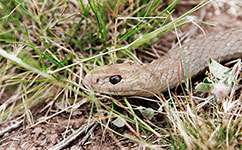Snake venom collected decades ago remains as potent as ever

Snake venom collected decades ago is as potent as ever, an international team of researchers has concluded. So we may be able to use it for research rather than collecting more in the field - good news for scientists and snakes alike.
The group analysed 52 samples of venom in historical collections all over Australia, aiming to find out whether they still have any potency left after decades in storage. The samples were taken as far back as 1935, and cover 13 species of snake in five genera, with some species represented by multiple regional variants.
The results, published in the Journal of Proteomics, were a big surprise. Unless the stoppers of their vials had decayed and let fresh air in, venoms were almost unchanged even after more than half a century.
If air had got in, it was a different story – the proteins in a sample of death adder venom whose stopper had failed was seriously degraded. But even in this case the venom was still almost as toxic to prey animals' nervous systems as fresh venom – the bits of protein that had decayed weren't the ones primarily responsible for killing prey.
Snake venoms are a sophisticated cocktail of highly specialised proteins, many of which have unique effects on mammals. They are an extremely promising source of new medical drugs, so demand for venom for research is rising. This research suggests existing venom collections may be able to help meet that demand.
The research was led by Australian researchers under Professor Bryan Fry of the University of Queensland. Dr Nick Casewell, a NERC research fellow at the Liverpool School of Tropical Medicine, was part of the team. 'We were really surprised; proteins are often quite sensitive to long-term storage and we certainly didn't expect to find most of the venoms almost as good as new,' he says.
The study suggests these 'vintage venom' collections are a precious scientific resource, particularly when they contain samples from snakes that are now rare or even extinct. Researchers can use these samples rather than having to keep going into the field to get new ones. This is good for the scientists who can avoid lengthy, difficult and expensive expeditions to find snakes and the potentially dangerous business of catching them. It's also good for snakes, which avoid the stressful experience of being caught and milked.
In many places snake populations are under huge threat from the destruction of their habitats; an estimated 12 per cent of species worldwide are threatened with extinction. So many venoms are likely to become increasingly hard to get hold of - in some cases impossible, if a species has been driven to extinction.
Even if a species as a whole is safe for the moment, its sub-populations and the genetic diversity they represent can easily be lost as they often live in a very small area. Among the collections the authors studied were 14 tiger snake venom samples, including ones from populations on Babel Island, Flinders Island, King Island and St. Francis Island off Australia's south coast. These samples are probably the only ones ever collected from these populations; in some cases they no longer exist, so this is all we will ever have of their venom.
'We can conserve some useful biodiversity just by looking after these collections,' says Casewell. 'at the Liverpool School of Tropical Medicine we have a huge archive of snake venoms that have been collected since before the 1970s, and it's a great resource for scientific study, especially with the difficulty of getting more samples. First of all you need to get out to the country and get permission to collect snakes, which can be politically difficult and time-consuming. Then you need to find the snakes, which is often really hard to do - many venomous species are very secretive and it can take weeks of searching just to find one individual. And of course the rarer a snake is, the harder it is to find one.'
All Australian snakes come from the elapid family - one of the two major lineages of venomous snake, including groups like the taipans, the cobras and the mambas. Casewell says the next step would be to do similar research venom from the other major family, the vipers, to make sure they have the same long shelf-life.
More information: "Vintage venoms: Proteomic and pharmacological stability of snake venoms stored for up to eight decades." Journal of Proteomics. dx.doi.org/10.1016/j.jprot.2014.01.004.
Provided by PlanetEarth Online
This story is republished courtesy of Planet Earth online, a free, companion website to the award-winning magazine Planet Earth published and funded by the Natural Environment Research Council (NERC).



















